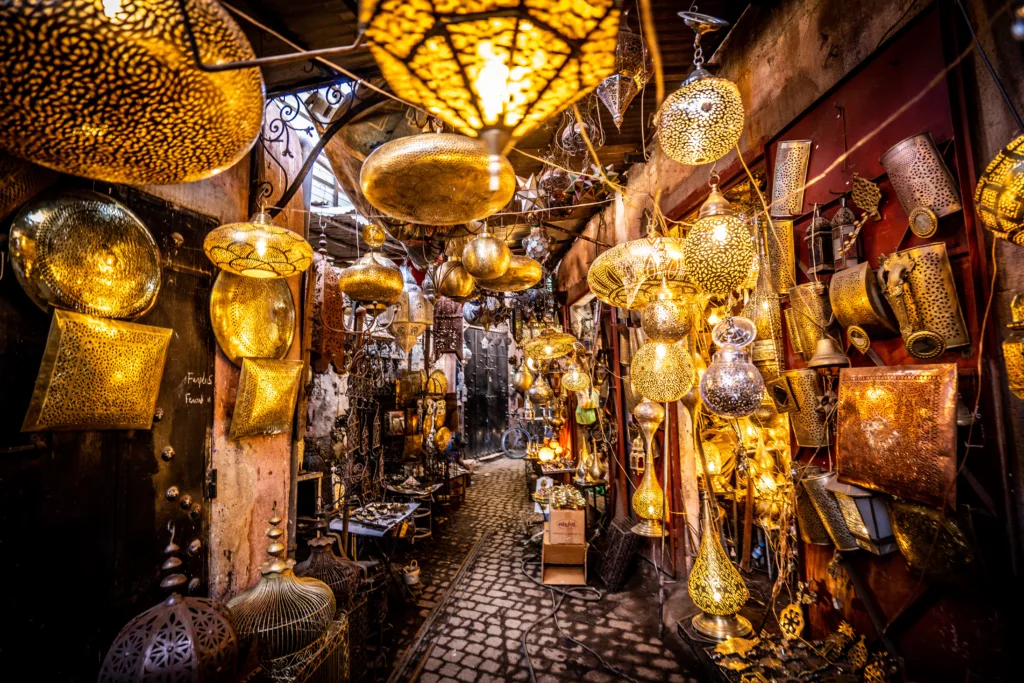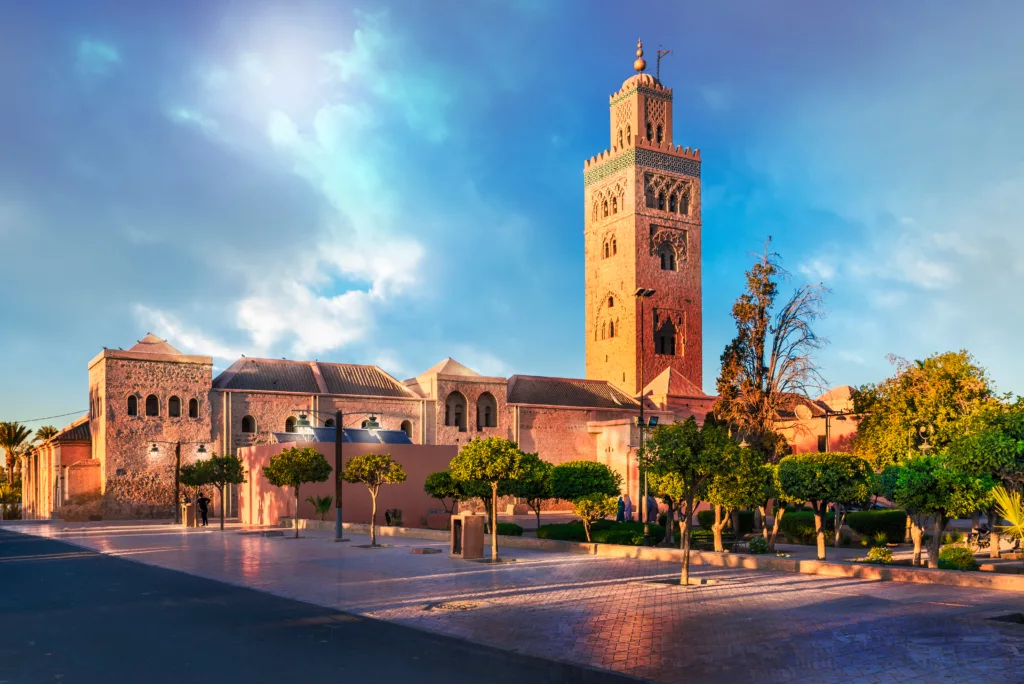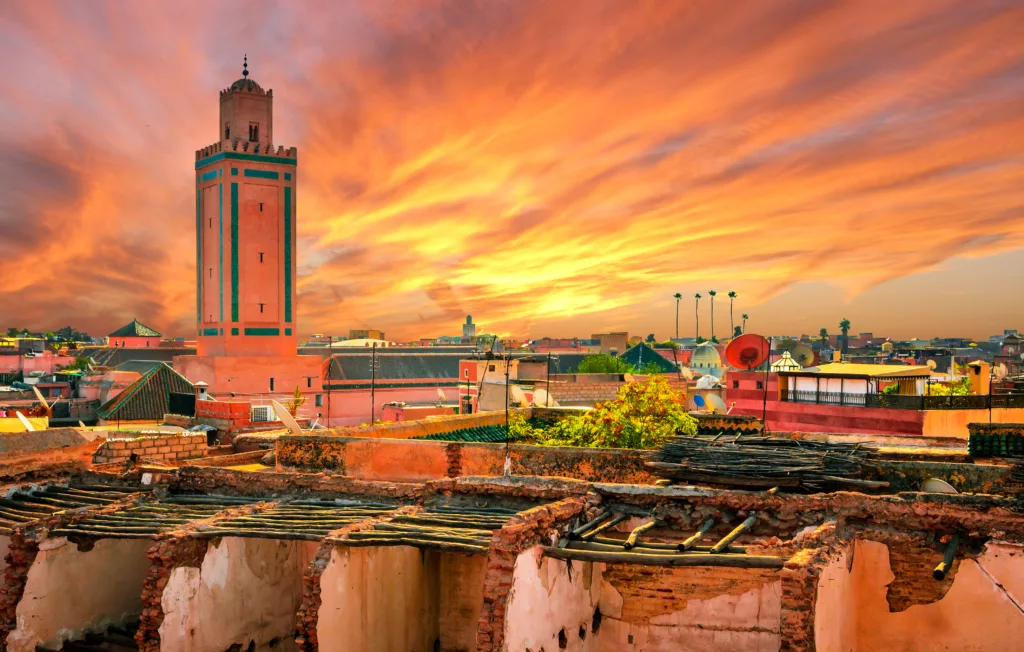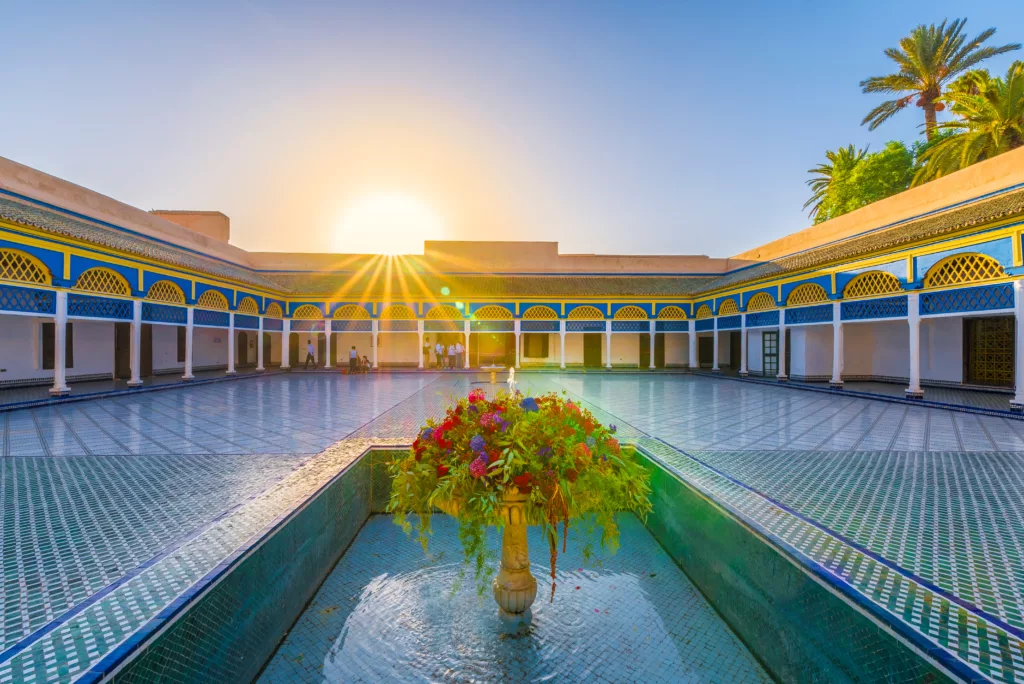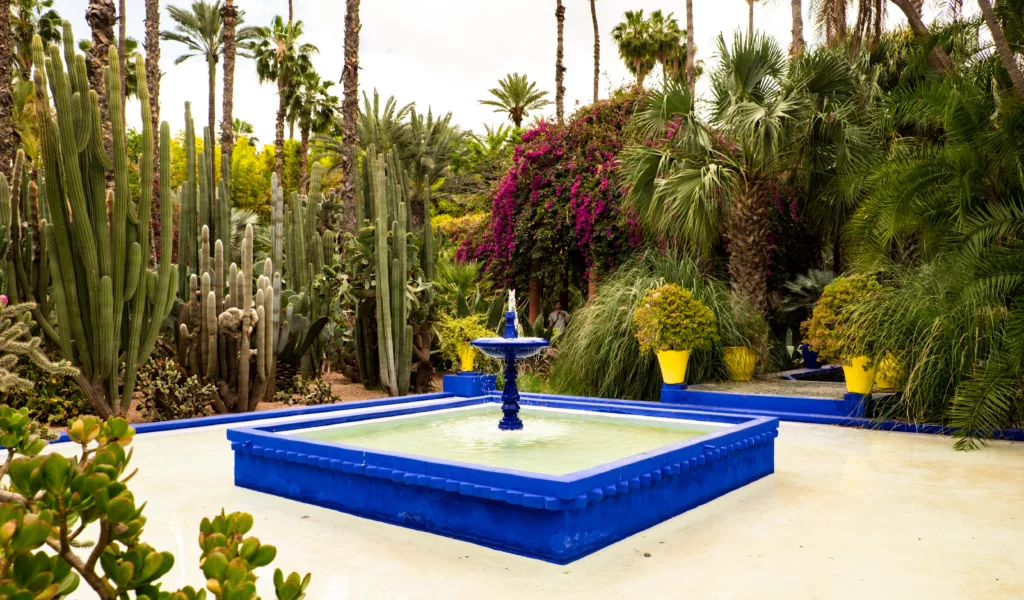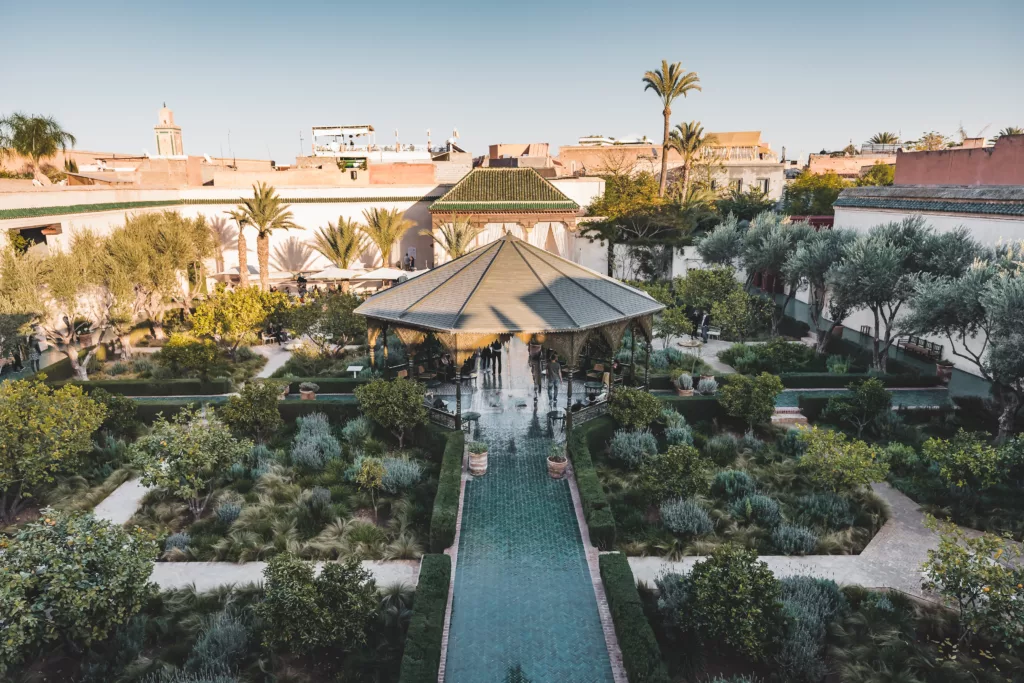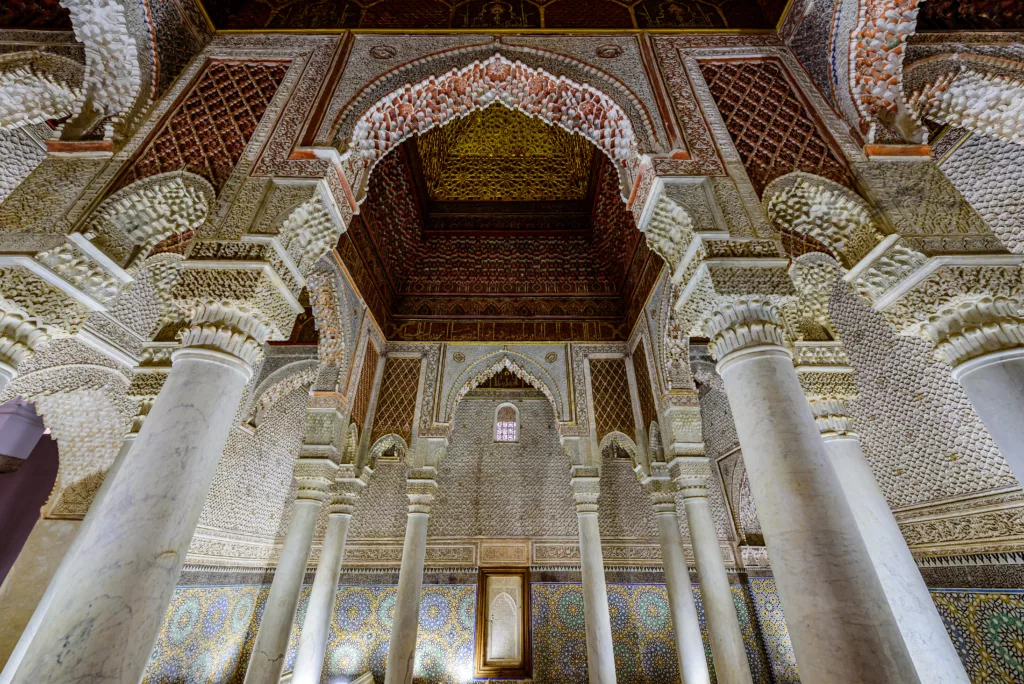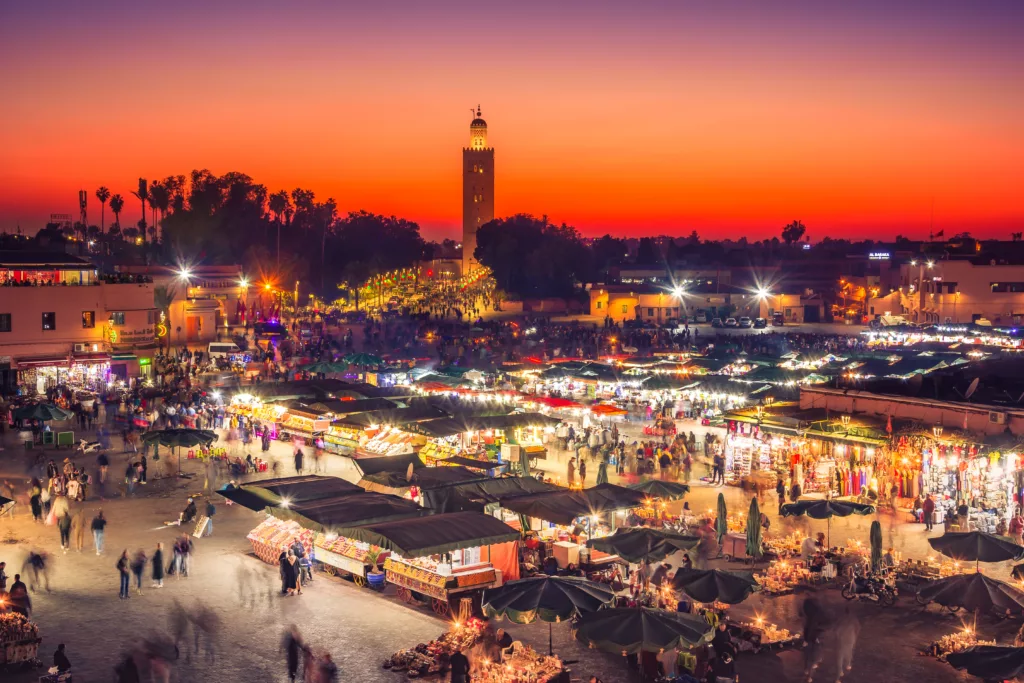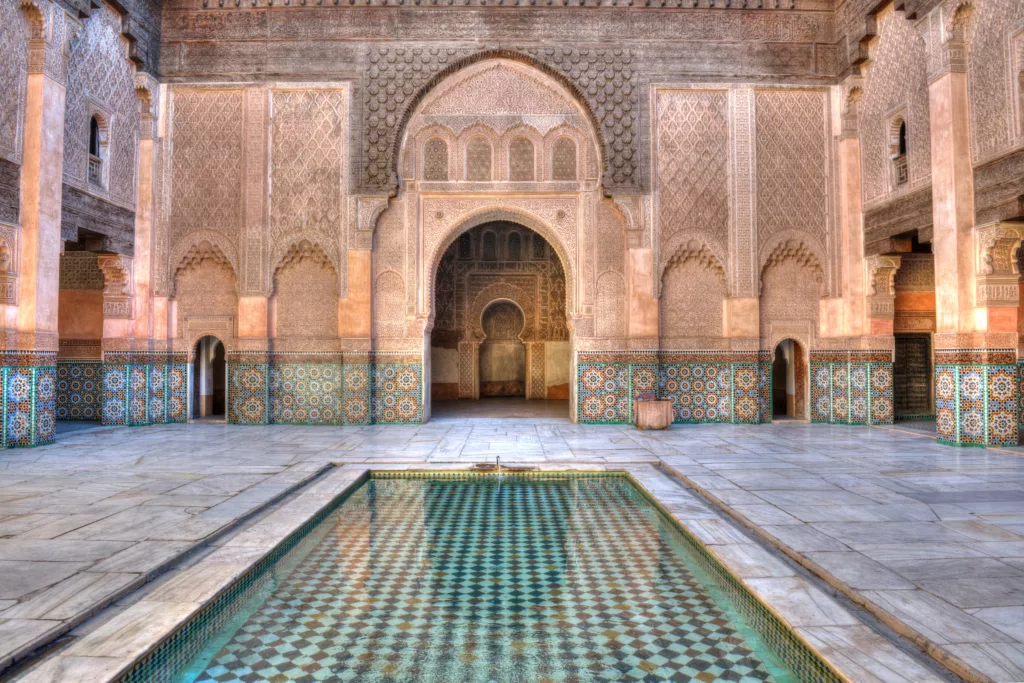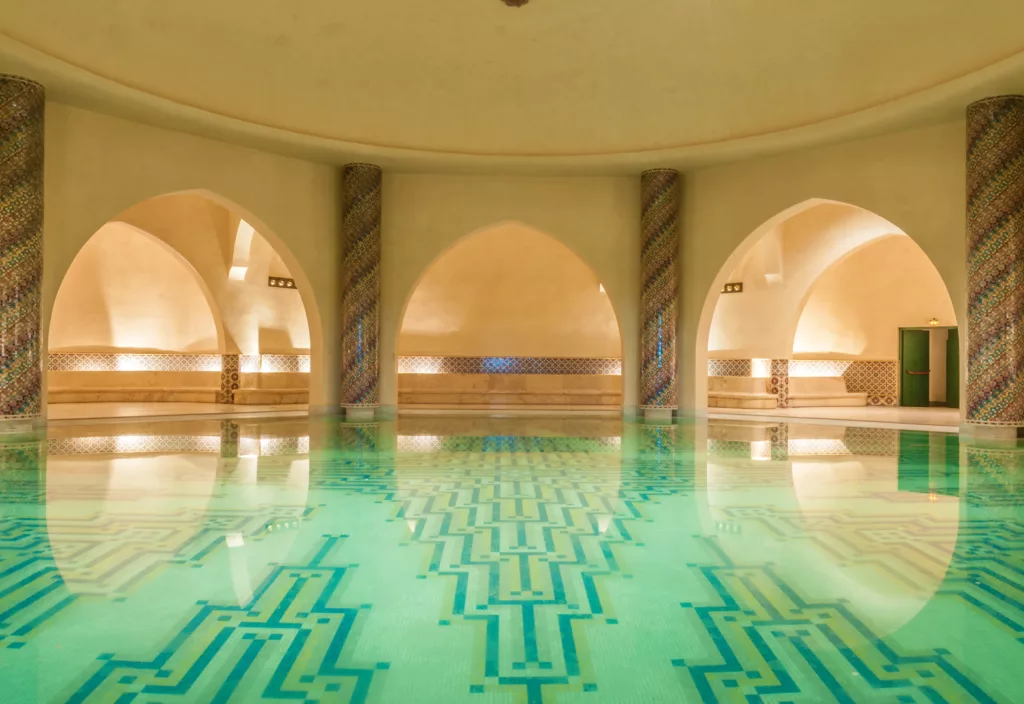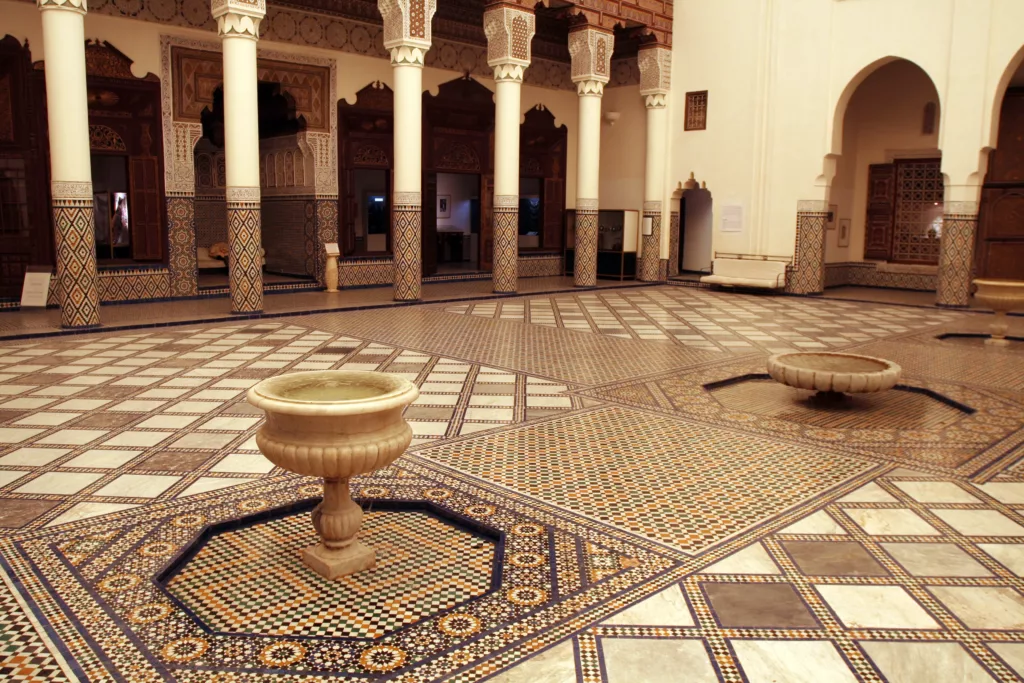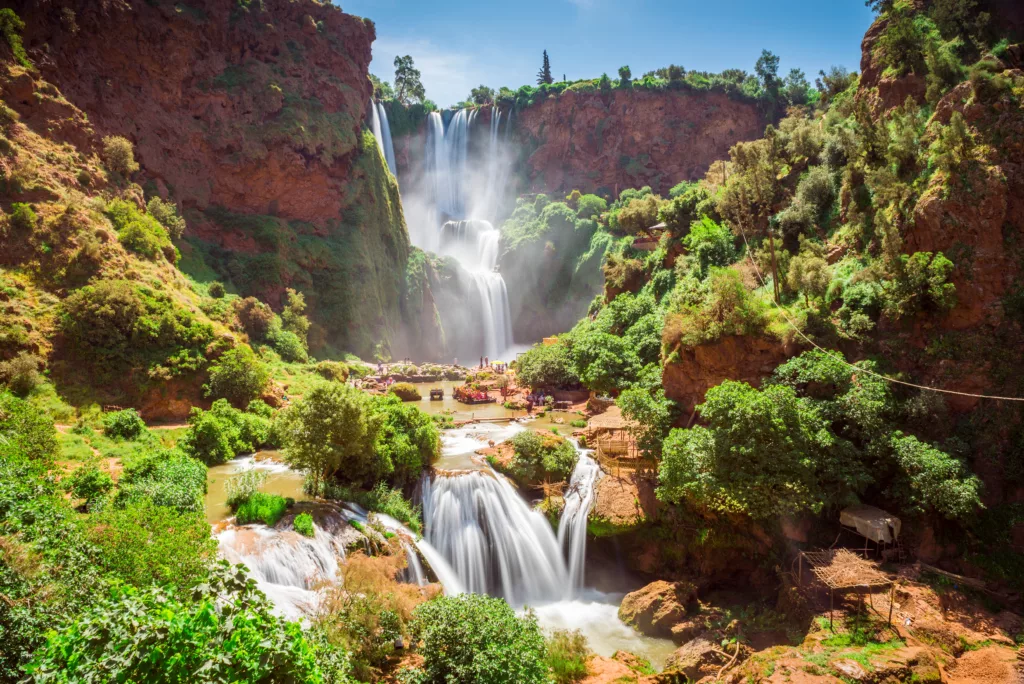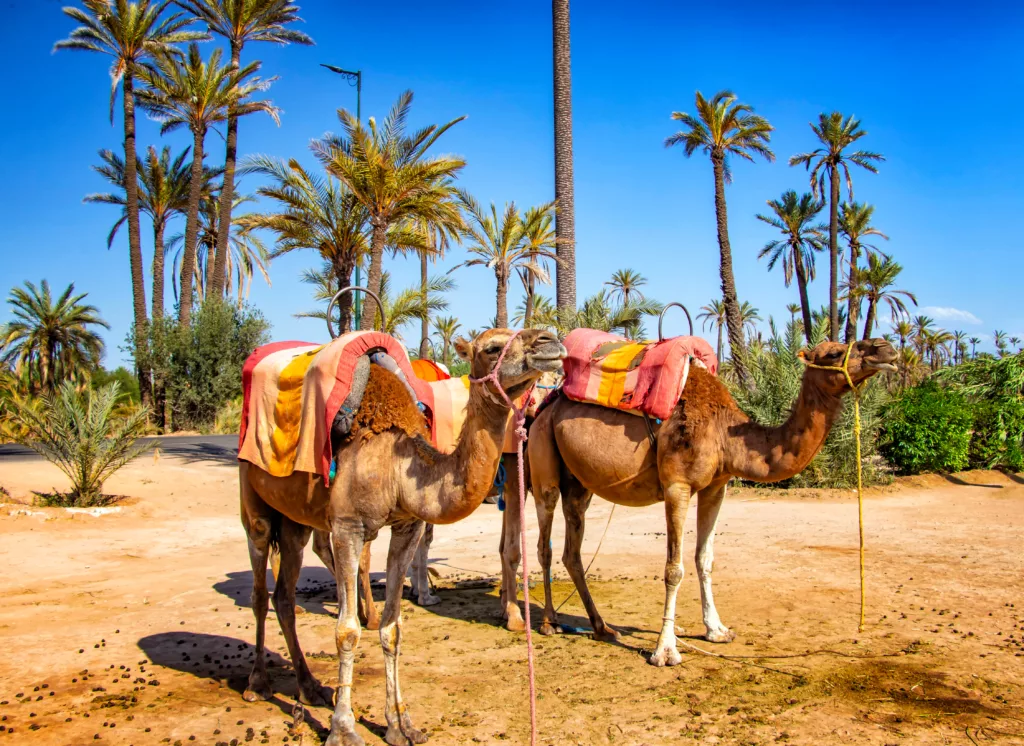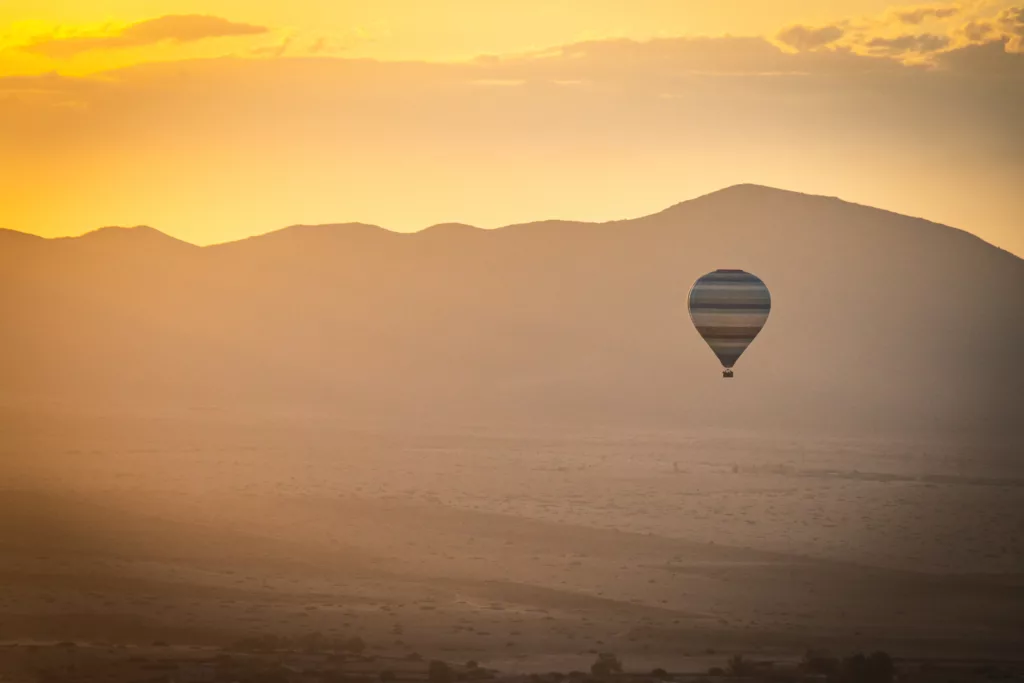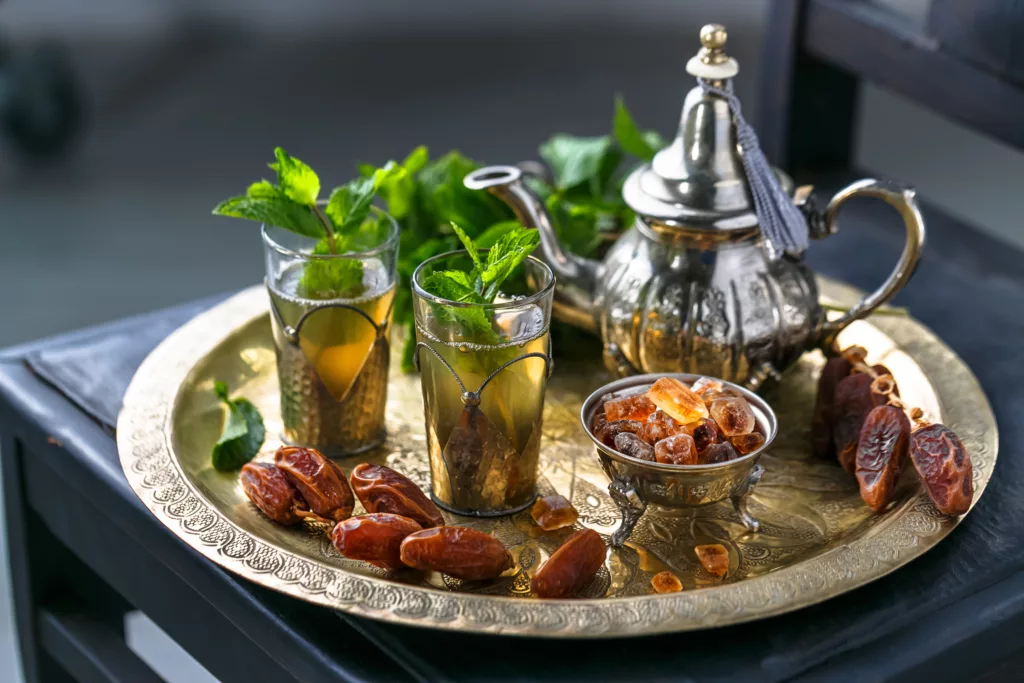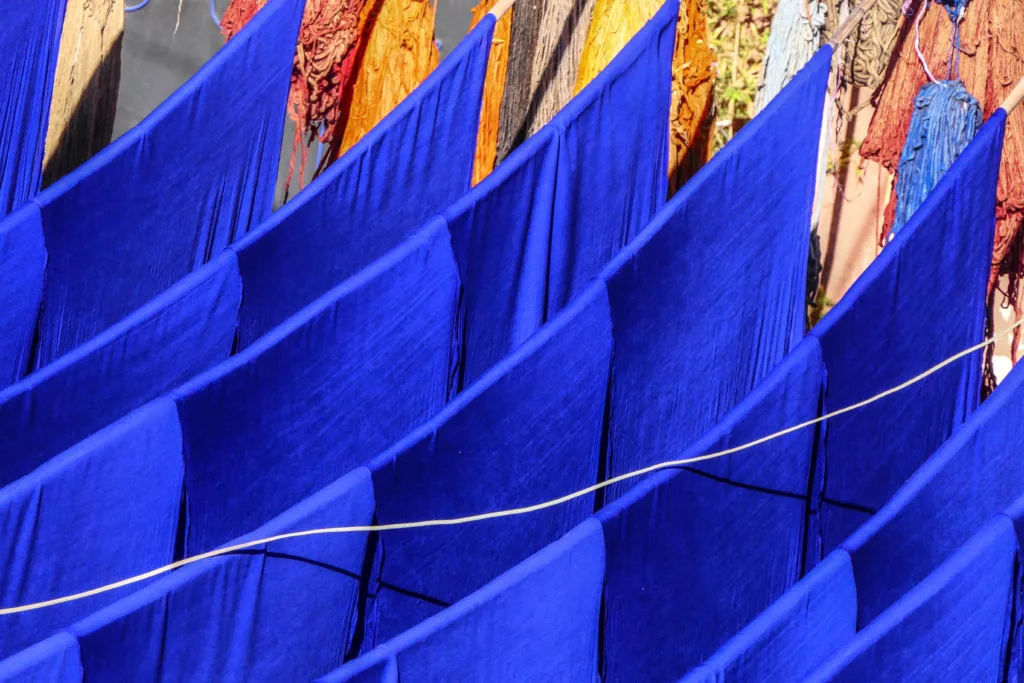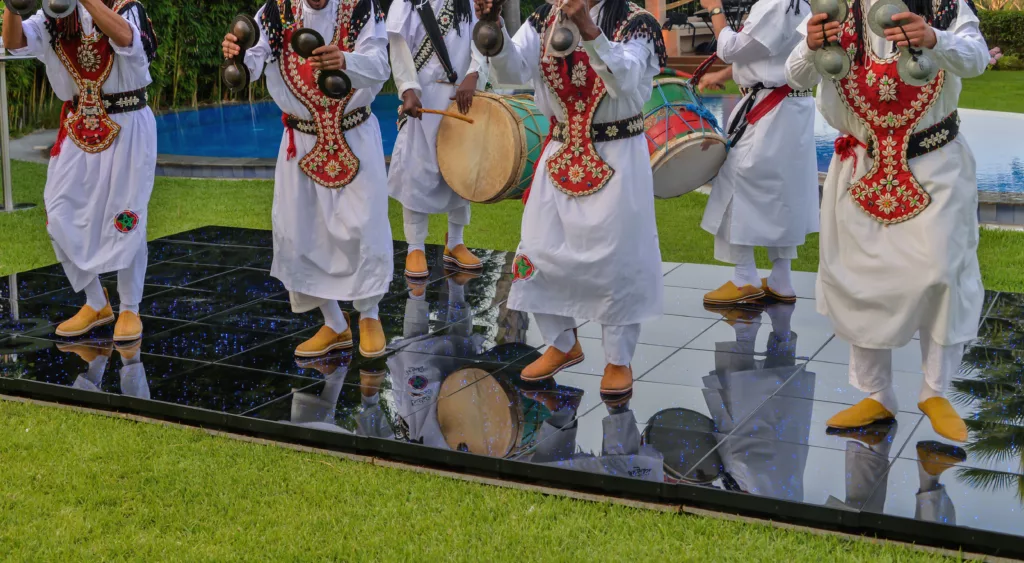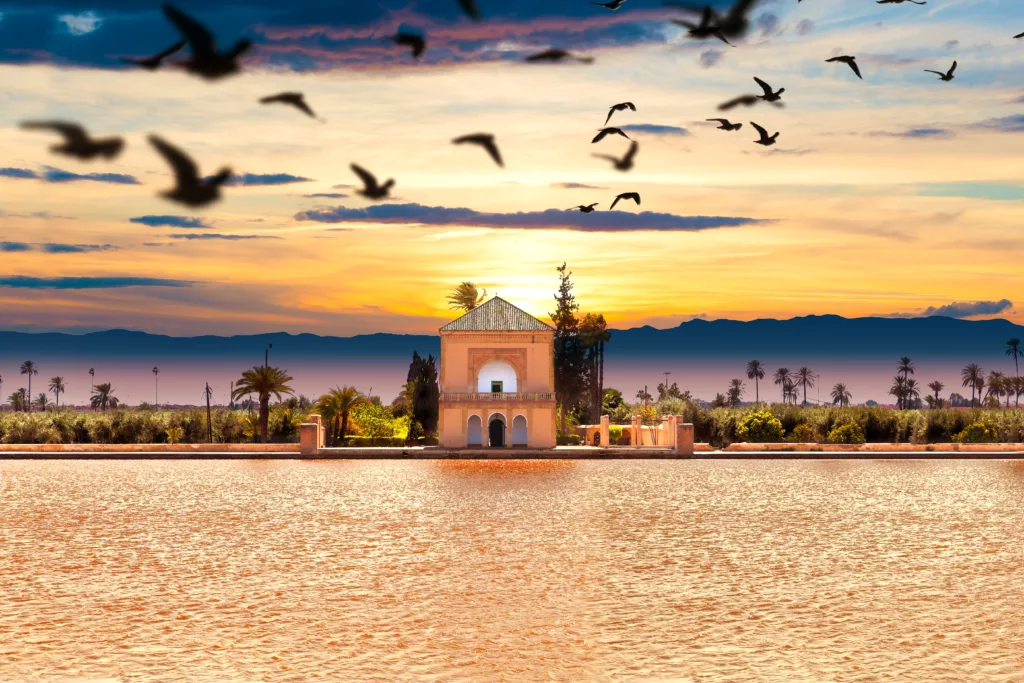Welcome to Marrakesh, the enchanting Moroccan city that paints a thousand vibrant images. Known as the Red City due to its distinctive red sandstone buildings, Marrakesh is a city like no other. It’s a destination where the past and present coexist in a beautiful symphony. Marrakesh beautifully brings together a unique blend of history, culture, and sensory stimulation. The city’s heart beats in its bustling souks, where the air is fragrant with spices, and the sounds of haggling tradesmen, chiming artisans, and the mesmerizing call to prayer provide an unforgettable soundtrack.
From wandering in the labyrinthine Medina to immersing yourself in the exotic beauty of its gardens, the city has a wealth of experiences to offer. The allure of Marrakesh lies in its ability to offer something for every traveler. Whether it’s the grandeur of historic palaces, the tranquility of lush gardens, or the sensory overload of vibrant marketplaces, Marrakesh never fails to enthrall its visitors. In this guide, we unveil 21 things to do in Marrakesh that beautifully blend the city’s renowned attractions with lesser-known gems that take you off the beaten path and into the city’s vibrant heart.
1. Visit the Koutoubia Mosque
Begin your exploration with the towering Koutoubia Mosque, Marrakesh’s largest mosque, a symbol of Islamic architecture, and a beacon of the city. With its imposing minaret standing at 77 meters high, the mosque is a landmark visible from various points around the city and a guiding beacon for the faithful and the curious alike.
The name ‘Koutoubia’ is derived from the Arabic word ‘kutubiyyin’ or ‘bookseller’, as the mosque was traditionally surrounded by a bustling marketplace selling manuscripts. Construction of the mosque began under the reign of the Almoravid Sultan, Abd al-Mu’min, and was completed during the Almohad Caliphate in the 12th century. The beautiful square stone minaret, crowned with four copper globes, is an embodiment of Almohad architecture and has inspired other notable buildings, including the Giralda in Seville and the Hassan Tower in Rabat.
One interesting feature of the Koutoubia Mosque is that it actually has two prayer halls. The first was built under the orders of Abd al-Mu’min but was misaligned with Mecca. Instead of demolishing it, a second, correctly aligned prayer hall was built. The minaret, a symbol of the city, was added later and was the model for La Giralda of Seville and for the Hassan Tower of Rabat.
While non-Muslims are not allowed to enter the mosque, it is worth appreciating its architectural grandeur from the outside. The garden surrounding the mosque offers a tranquil spot in the bustling city, with its neat rows of orange trees providing shade and scent.
Voyagix Tips
For an optimal visit to the Koutoubia Mosque, consider these tips:
- Getting There: The Koutoubia Mosque is located in the southwest Medina quarter of Marrakesh, within walking distance from Jemaa el-Fnaa square.
- Best Time to Visit: The mosque is beautiful at any time of the day, but it is particularly striking at sunset when the stone glows a warm orange. The call to prayer at this time adds to the atmosphere.
- What to Bring: Although non-Muslims cannot enter, it’s respectful to dress modestly when visiting the grounds. Also, consider bringing a camera to capture the architectural splendor of the minaret.
- Respect the Faith: Remember, the Koutoubia Mosque is an active place of worship. Please respect worshipers, especially during prayer times.
Regardless of your faith, the Koutoubia Mosque is a must-see for its historical and architectural significance. It stands as a testament to Marrakesh’s rich cultural heritage and the city’s intertwining of the secular and spiritual.
2. Wander in the Medina
Next, immerse yourself in the hustle and bustle of the Medina, a UNESCO World Heritage site filled with narrow alleys, colorful markets, and enchanting courtyards. The Medina is the historic heart of Marrakesh, dating back to the city’s founding in 1070. It’s a labyrinthine world of hidden treasures where the old and the new, the tranquil and the bustling, the ordinary and the extraordinary meet.
Walking through the Medina’s narrow, winding streets is like stepping back in time. The alleys are lined with shops selling everything from traditional Moroccan carpets and leather goods to jewelry and spices. The vibrant colors and alluring scents of the marketplaces, or souks, are a sensory overload that is quintessentially Marrakesh.
Yet, the Medina is more than just markets. It’s home to some of the city’s most significant architectural sites, including the Ben Youssef Madrasa and the Bahia Palace. The former, a 16th-century Islamic college, showcases intricate Islamic art and architecture, while the latter is a magnificent example of Moroccan and Islamic styles, with beautiful gardens and stunning tile work.
Living quarters, known as riads, are another key feature of the Medina. These traditional Moroccan houses are built around a central courtyard and often extravagantly decorated. Many have been transformed into hotels or restaurants, providing a tranquil respite from the busy streets.
Voyagix Tips
For an optimal visit to the Medina, consider these tips:
- Getting There: The Medina is located in the city center. Taxis are plentiful but be sure to agree on a price before you get in.
- Best Time to Visit: Mornings and late afternoons are the best times to visit the Medina when it’s less crowded, and the weather is cooler.
- What to Bring: Bring cash for purchases in the souks, a camera for the amazing photo opportunities, and wear comfortable shoes for walking.
- Navigating the Medina: The Medina can be a labyrinth. Consider hiring a local guide or using a map or GPS on your phone. Check out Maps.me for an offline map.
- Bargaining: Bargaining is a part of the shopping experience. Don’t be afraid to negotiate prices.
The Medina is not just a place, it’s an experience. With its vibrant souks, significant monuments, and unique riads, it encapsulates the spirit of Marrakesh, serving up an intoxicating blend of sights, sounds, and smells that will linger long in your memory.
3. Explore the Bahia Palace
Step into the grandeur of the 19th-century Bahia Palace, a splendid representation of Moroccan and Islamic architecture. Commissioned by the grand vizier of the sultan for his personal use, this palace is an enchanting world of luxury and craftsmanship.
The Bahia Palace is an architectural marvel spread across eight hectares, with a stunning network of courtyards, gardens, and beautifully decorated rooms. Its name, “Bahia”, translates to “brilliance”, reflecting the intention to be the greatest palace of its time. From the marble-paved courtyards adorned with zellige tilework and fountains to the opulent rooms with intricate stucco and cedar-wood carvings, every corner of the palace exudes splendor.
Each part of the palace offers an insight into the lavish lifestyle of the vizier and his family. The harem quarters, where the vizier’s wives and concubines lived, are particularly fascinating, showcasing the best of Moroccan and Andalusian design aesthetics.
Another highlight is the palace’s lush gardens filled with a variety of plants, orange trees, and fragrant flowers, providing a serene escape from the city’s hustle and bustle. These verdant spaces were designed to be an earthly representation of paradise, in keeping with Islamic tradition.
Voyagix Tips
For an optimal visit to the Bahia Palace, consider these tips:
- Getting There: The Bahia Palace is located in the Medina. It’s walkable from most parts of the Medina, or you can take a taxi.
- Best Time to Visit: The palace is less crowded early in the morning or late in the afternoon. Visit during these times to fully appreciate its beauty.
- Admission: There’s an admission fee to enter the palace. You can check the latest information on the official tourism website.
- Tour Guide: Consider hiring a guide to better understand the history and significance of the architectural elements.
Visiting the Bahia Palace is like stepping into a dream, a fairy tale of a bygone era. Its stunning architecture, intricate decorations, and peaceful gardens provide a glimpse into the grandeur of Morocco’s past, making it a must-see attraction in Marrakesh.
4. Stroll through the Majorelle Garden
Escape the city’s hustle in the serene Majorelle Garden, a botanical garden designed by French painter Jacques Majorelle and later owned by fashion designer Yves Saint Laurent. This two and a half acre garden is a vibrant Eden filled with exotic plants and trees, vibrant paths, and striking cobalt blue accents, reflecting the painter’s fascination with intense colors.
Jacques Majorelle dedicated forty years of his life to creating this enchanting oasis. Home to more than 300 species of stunning plants from the five continents including cacti, palms, bamboo, and more, the Majorelle Garden is a real feast for the eyes. Majorelle’s art studio, painted in a distinctive shade of blue called ‘Majorelle Blue’, adds to the garden’s unique charm.
In 1980, the garden was saved from a real estate project when it was purchased by fashion designer Yves Saint Laurent and his partner Pierre Bergé. They restored the garden, introducing new plant species and transforming it into an inspiring haven that blends art, nature, and fashion. Today, a memorial to Yves Saint Laurent, who once said that he could find unlimited inspiration in the garden, stands in the garden.
Also housed within the garden is the Berber Museum, showcasing the rich culture and heritage of Morocco’s indigenous people.
Voyagix Tips
For an optimal visit to Majorelle Garden, consider these tips:
- Getting There: Majorelle Garden is located in the city center and is easily accessible by taxi.
- Best Time to Visit: The garden can get busy. To avoid crowds, consider visiting early in the morning.
- Admission: There’s an admission fee for both the garden and the Berber Museum. You can check the official website for the most recent prices.
- Take Your Time: Allow enough time to enjoy the garden’s beauty and serenity and explore the Berber Museum.
Whether you’re a nature lover, art enthusiast, or just looking for a peaceful retreat, the Majorelle Garden offers a wonderful respite from the bustle of Marrakesh, where you can immerse yourself in the beauty of nature and art.
5. Get Lost in the Jardin Secret
Discover the tranquil Jardin Secret, an oasis of serenity and beauty nestled in the heart of the Medina. Literally translating to ‘The Secret Garden’, it stands true to its name as a hidden gem amongst the bustling streets of Marrakesh.
This historic 19th-century palace complex, restored to its former glory, is divided into an exotic and an Islamic garden, providing a peaceful sanctuary away from the city’s hustle and bustle. The gardens are a marvel of traditional Moroccan and Islamic architecture, evoking the paradisiacal gardens described in the Quran.
The Exotic Garden is a tribute to the diversity of plants around the world, showcasing a varied collection of species from different continents. On the other hand, the Islamic Garden reflects the traditional Moroccan garden, designed in a geometric pattern with a central water feature. Here, you’ll find a variety of aromatic and medicinal plants native to the region.
One of the highlights of the Jardin Secret is the stunning observation tower. Climb up for a mesmerizing panoramic view of the garden, the Medina, and the snow-capped Atlas Mountains in the distance. Also, make sure to visit the beautiful bookshop and the café for a refreshing Moroccan mint tea.
Voyagix Tips
For an optimal visit to Jardin Secret, consider these tips:
- Getting There: Jardin Secret is centrally located in the Medina, a short walk from the main square, Jemaa el-Fnaa.
- Best Time to Visit: The garden is open year-round. However, to avoid crowds, consider visiting early in the morning.
- Admission: There’s an admission fee for the garden and the tower. Check the official website for the most recent prices.
- Take Your Time: Allow at least an hour to relax in the gardens and enjoy the surroundings.
Whether you’re a lover of nature, architecture, or simply seeking a moment of tranquility, the Jardin Secret offers a refreshing escape from the bustling streets of Marrakesh.
6. Visit the Saadian Tombs
Step back in time and pay a visit to the Saadian Tombs, an architectural masterpiece that remained undiscovered for hundreds of years. Dating back to the Saadian dynasty that ruled over Marrakesh in the 16th and 17th centuries, these tombs are a captivating testament to a significant period in Moroccan history.
This complex comprises more than a hundred mosaic-decorated tombs that house the remains of members of the Saadian royal family, including Sultan Ahmed al-Mansour. Secluded behind high walls and largely forgotten, these tombs remained a secret until their rediscovery in 1917, during a French aerial survey.
Upon entering, you’re greeted by a series of gracefully arching pathways that lead to two main mausoleums. The first mausoleum, known as the Hall of Twelve Columns, is arguably the most opulent, housing the tomb of Sultan Ahmed al-Mansour himself. The room is lavishly decorated with Italian Carrara marble, intricate cedar woodwork, and stunning zellij mosaics, evoking a sense of the Saadian era’s grandeur.
Don’t miss the garden, a peaceful courtyard dotted with numerous tombstones arranged around mature cypress trees. It’s a solemn yet beautiful place, offering a poignant perspective on Marrakesh’s past.
Voyagix Tips
For an optimal visit to the Saadian Tombs, consider these tips:
- Getting There: The Saadian Tombs are located near the Kasbah Mosque. Taxis are readily available throughout Marrakesh, but remember that the tombs are also easily reachable on foot from the city center.
- Best Time to Visit: To avoid large crowds, try visiting early in the morning or late in the afternoon.
- Admission: There is a small entrance fee. For the latest information, visit the official website of the Moroccan Ministry of Culture.
- Take Your Time: Allocate around an hour to take in the architectural splendor of this historical gem and reflect on the city’s storied past.
Whether you’re a history buff, an architecture enthusiast, or simply interested in understanding the region’s past, a visit to the Saadian Tombs is a journey into Marrakesh’s rich heritage.
7. Experience the Night Market at Jemaa el-Fnaa
As night falls, immerse yourself in the electrifying atmosphere of Jemaa el-Fnaa, Marrakesh’s iconic main square. A sensory overload in the best possible way, the square comes alive with an eclectic mix of sights, sounds, and scents that capture the essence of Moroccan culture.
Declared a Masterpiece of the Oral and Intangible Heritage of Humanity by UNESCO, Jemaa el-Fnaa is the beating heart of the city. Musicians with their traditional instruments fill the air with mesmerizing melodies, while snake charmers and henna artists gather around, vying for your attention.
Walking around, you’ll encounter a cornucopia of food stalls serving traditional Moroccan cuisine. From steaming bowls of harira soup to tender skewers of lamb, succulent seafood, and sweet treats like honey-drizzled pastries, there’s something to tantalize every taste bud. The aroma of spices mingling in the air is simply irresistible. Don’t forget to try the fresh orange juice, a local favorite, available at the countless juice stalls.
The square is also a stage for traditional storytelling and performance arts, showcasing a fascinating blend of Moroccan cultural expressions. It’s not just a place, it’s an experience that truly brings you closer to the soul of Marrakesh.
Voyagix Tips
For an optimal visit to Jemaa el-Fnaa, consider these tips:
- Negotiate: It’s not uncommon for vendors or performers to ask for tips. Feel free to politely negotiate the price or decline if you’re not interested.
- Street Food: Follow the locals when it comes to selecting a food stall. They usually know where the best food is! Do bear in mind hygiene, however, and stick to stalls that look clean and are busy with customers.
- Be Respectful: Remember, the performers are here to earn a living. Always ask for permission before taking photos.
- Evening Visit: Jemaa el-Fnaa is best experienced at night when it truly comes alive. However, it can get crowded, so keep an eye on your belongings.
Visiting Jemaa el-Fnaa is a celebration of Marrakesh’s vibrant culture. It’s an unforgettable experience that promises to leave a lasting impression.
8. Visit the Ben Youssef Madrasa
Step into a world of intricate design and rich history at the Ben Youssef Madrasa, one of the largest Islamic colleges in Morocco. Established in the 14th century and refurbished in the 16th century, it stands as an awe-inspiring representation of the splendid Moroccan and Islamic architecture and the importance of education in the Islamic world.
As you explore the Madrasa, marvel at the exquisite craftsmanship that adorns every inch of the complex. From the beautifully carved cedar woodwork, the delicate stucco, and the vibrant zellij (geometric tilework), each detail is a testament to the refined aesthetics of the time.
The heart of the Madrasa is its large courtyard, a serene space framed by archways and galleries. Its dazzling tiled floor and ornate central pool reflect the heavens above, creating an atmosphere of divine tranquility.
Step into the student cells that line the upper floors, each a tiny, humble space that once housed the scholars studying Islamic law. From the roof, you can enjoy views over the medina, its bustling maze contrasting with the quiet reflection of the Madrasa.
Voyagix Tips
For an enriching visit to Ben Youssef Madrasa, consider these tips:
- Take Your Time: Don’t rush your visit. The detailed artistry of the Madrasa deserves a slow, appreciative look.
- Guided Tour: A guided tour can provide valuable insights into the history and significance of the Madrasa. The official website offers some options.
- Photography: The Madrasa is a photographer’s dream with its intricate details. Be respectful of the location’s significance and avoid using flash.
- Best Time to Visit: Early morning or late afternoon visits can help avoid large tourist groups.
Visiting the Ben Youssef Madrasa is like stepping into a living testament of Marrakesh’s historic culture and intellectual heritage. It’s an unmissable experience that brings the city’s past vibrantly to life.
9. Soak in a Traditional Hammam
A visit to Marrakesh wouldn’t be complete without experiencing a traditional Moroccan hammam. Rooted in Moroccan culture and ritual, these public steam baths offer visitors a unique opportunity to rejuvenate, relax, and immerse themselves in local customs.
Entering a hammam, you’ll first step into a warm room, where you will undress and wrap yourself in a traditional cotton towel known as a ‘pestemal’. Following this, you’ll move to the hot room, where you’ll steam to open your pores and prepare your skin for the cleansing process.
After steaming, a Hammam attendant will exfoliate your body using a ‘kessa’ glove, removing dead skin and impurities. Then, you’ll be lathered in a thick layer of ‘rhassoul’, a natural Moroccan clay, and ‘savon noir’, a soap made with olive oil. After a rinse, the process ends with a relaxing massage, leaving you feeling refreshed and revitalized.
The hammam experience is not just about physical cleanliness; it is also a social ritual, a place of gathering and community, making it an essential aspect of Moroccan life.
Voyagix Tips
For an enriching Moroccan hammam experience, consider these tips:
- Choosing a Hammam: Marrakesh is home to various hammams, from basic local baths to luxury spa retreats. Hammam de la Rose and Les Bains de Marrakech come highly recommended.
- Respect Local Customs: Traditional hammams separate men and women, either by having separate sections or different operating hours. Always respect local customs and rules.
- Booking: For popular hammams, it is advisable to book your session in advance. You can usually do this on their official websites.
- What to Bring: Typically, hammams provide everything you’ll need, including towels and toiletries. However, if you prefer, you can bring your own.
A traditional Moroccan hammam offers a blissful blend of relaxation, rejuvenation, and cultural immersion. It is an essential Marrakesh experience and the perfect antidote to the bustling medina.
10. Explore the Marrakesh Museum
Nestled in the bustling heart of Marrakesh is the stunning Marrakesh Museum, located in the historic Dar Menebhi Palace. The palace itself is a work of art, showcasing classic Moroccan architecture with Andalusian and Moorish influences.
The museum takes you on a fascinating journey through the history, art, and culture of Morocco. Its rich collection includes a diverse range of Moroccan art from various periods and regions, showcasing traditional and contemporary Berber, Moroccan Arabic, and Jewish artifacts, including pottery, coins, textiles, and scriptures. The museum also holds temporary exhibitions, lectures, and workshops to encourage cultural exchanges.
One of the museum’s highlight is the grand courtyard, a breathtaking space with intricately carved stucco arches, a stunning central chandelier, and a beautiful marble fountain. The serene atmosphere of the courtyard contrasts wonderfully with the bustling streets outside, providing a moment of calm amidst the city’s hustle and bustle.
This museum visit offers a glimpse into the rich tapestry of Moroccan culture, revealing the shared history and diverse influences that have shaped this unique country.
Voyagix Tips
For a memorable visit to the Marrakesh Museum, consider these tips:
- Planning Your Visit: The museum is open every day, from 9 a.m. to 6:30 p.m. It’s a great escape from the midday heat or a rainy day activity.
- Guided Tours: For a deeper understanding of the exhibits, consider hiring a guide or booking a tour. You can usually find more information on the museum’s official website.
- Combined Ticket: If you’re also planning to visit the Ben Youssef Madrasa, consider purchasing a combined ticket for a discounted entry to both attractions.
- Photography: Feel free to take photographs, but be respectful of other visitors and avoid using flash when necessary.
Whether you’re a history buff, art lover, or just interested in Moroccan culture, a visit to the Marrakesh Museum is an enriching experience that will deepen your appreciation for this incredible city.
11. Discover Moroccan Cuisine in a Cooking Class
There’s no better way to understand a country’s culture than through its food. In Marrakesh, you can dive right into the heart of Moroccan culinary traditions with a traditional Moroccan cooking class. This engaging, hands-on experience offers a unique opportunity to immerse yourself in the rich flavors, aromatic spices, and time-honored cooking techniques of Moroccan cuisine.
A typical Moroccan cooking class begins with a visit to a local souk, where you’ll learn to select fresh, locally-sourced ingredients. You’ll be guided through a labyrinth of stalls brimming with vibrant produce, fragrant spices, and fresh meats, getting a sense of the everyday life and culture of the Moroccan people. It’s a feast for the senses and a fantastic insight into the foundation of every delicious Moroccan dish.
Back in the cooking school, under the guidance of an experienced chef, you’ll learn to prepare traditional dishes such as couscous, tagine, and pastilla. You’ll discover the secrets behind the perfect blend of spices, the art of slow-cooking a tagine, and the delicate balance of sweet and savory flavors that define Moroccan cuisine.
After your culinary adventure, you’ll get to savor the fruits of your labor in a convivial atmosphere, often accompanied by traditional Moroccan mint tea. Not only will you leave with a satisfied palate, but you’ll also have the skills to recreate a piece of your Moroccan journey back home.
Voyagix Tips
For a memorable Moroccan cooking class, consider these tips:
- Selecting a Class: Choose a class that offers a market tour as part of the experience. This allows you to learn about the ingredients you’ll be using. Websites like Cookly offer various cooking class options.
- Dietary Restrictions: If you have dietary restrictions, inform the class organizer in advance so they can make necessary adjustments.
- Clothing: Wear comfortable clothing and closed-toe shoes. An apron is usually provided.
- Taking Recipes Home: Most classes provide you with the recipes so you can recreate the dishes back home. Don’t forget to take notes!
A Moroccan cooking class is not just about learning to cook—it’s a cultural experience that offers a flavorful glimpse into the country’s traditions and lifestyle.
12. Take a Day Trip to the Atlas Mountains
After immersing yourself in Marrakesh’s vibrant city life, a day trip to the breathtaking Atlas Mountains provides a refreshing change of scenery. These majestic mountain ranges stretch across Morocco, offering a serene escape filled with stunning landscapes, picturesque Berber villages, and a plethora of outdoor activities.
Begin your journey by travelling through the Ourika Valley, the gateway to the High Atlas region. Here, you’ll be treated to panoramic views of verdant valleys, terraced agriculture, and rugged mountain peaks. Further up the winding roads, you’ll encounter traditional Berber villages that seem untouched by time. These humble hamlets, with their mud-brick houses and terraced fields, offer a fascinating insight into Morocco’s rural life.
Hiking enthusiasts will find plenty of trails weaving through the mountains. The hike up to the Setti Fatma waterfalls is a popular choice, leading you through lush landscapes to a breathtaking cascade. For those seeking more adventure, there are opportunities for mountain biking along the rugged terrain. Whichever path you choose, the Atlas Mountains’ beauty promises a memorable experience.
Finally, no trip to the Atlas Mountains would be complete without visiting a Berber home. Often arranged by tour operators, these visits allow you to experience the locals’ warm hospitality and learn about their lifestyle, traditions, and centuries-old customs.
Voyagix Tips
For an unforgettable day trip to the Atlas Mountains, consider these tips:
- Choose the Right Tour: There are numerous tour operators offering Atlas Mountain day trips. Choose a reputable one that caters to your interests, whether it’s hiking, mountain biking, or cultural immersion. Websites like Viator offer a variety of options.
- Prepare for the Weather: The temperature in the Atlas Mountains can be significantly cooler than in Marrakesh, especially at higher altitudes. Pack layers and wear appropriate footwear for hiking.
- Respect the Locals: When visiting Berber villages, respect the local customs. Ask for permission before taking photos of locals or their homes.
- Stay Hydrated: Whether hiking or mountain biking, remember to carry enough water to stay hydrated throughout the day.
An excursion to the Atlas Mountains offers a wonderful contrast to the bustling city life of Marrakesh, showcasing the diverse experiences that Morocco has to offer.
13. Shop in the Souks
Immerse yourself in a sensory explosion by stepping into the vibrant souks of Marrakesh. These bustling marketplaces, scattered throughout the city, are a vital part of Moroccan life. The souks are a maze of narrow alleyways lined with tiny shops and stalls, where you can buy virtually anything, from fragrant spices and handcrafted leather goods to exquisite ceramics and intricately woven carpets.
The most famous of these markets is the Souk Semmarine, the largest souk in Marrakesh, offering an array of goods. As you wander through the labyrinthine lanes, the scent of freshly ground spices, the chatter of vendors, the clang of metalworkers, and the vibrant display of goods create an enchanting atmosphere that is quintessentially Moroccan.
Among the treasures to be found are traditional Moroccan slippers known as babouches, beautiful kaftans, brass lanterns, and argan oil. Another highlight is the carpet souk, where you can find rugs woven in traditional Berber designs. Remember, haggling is a norm here; vendors expect you to negotiate prices.
Visiting the souks is not just about shopping; it’s also a cultural experience. You can watch local artisans at work, creating beautiful crafts using centuries-old techniques. It’s a fascinating glimpse into Moroccan traditions and craftsmanship.
Voyagix Tips
To make the most out of your visit to the Marrakesh souks, consider the following tips:
- Master the Art of Bargaining: Haggling over prices is a part of the shopping experience in Moroccan souks. Don’t be afraid to negotiate, but always do it in a respectful manner. For more tips on haggling, consider reading this Lonely Planet guide.
- Visit with a Guide: The souks can be quite overwhelming for first-time visitors. Hiring a local guide can help you navigate the labyrinthine market and provide insights into the products and their prices.
- Respect the Local Customs: Always ask for permission before photographing people or their goods. Also, dress modestly to respect the local culture.
- Watch Out for Pickpockets: Like any crowded place, pickpockets can be a concern in the souks. Keep your belongings secure and be aware of your surroundings.
A visit to Marrakesh’s souks provides a colorful and captivating experience that is an integral part of any Moroccan adventure.
14. Visit the Museum of African Contemporary Art Al Maaden
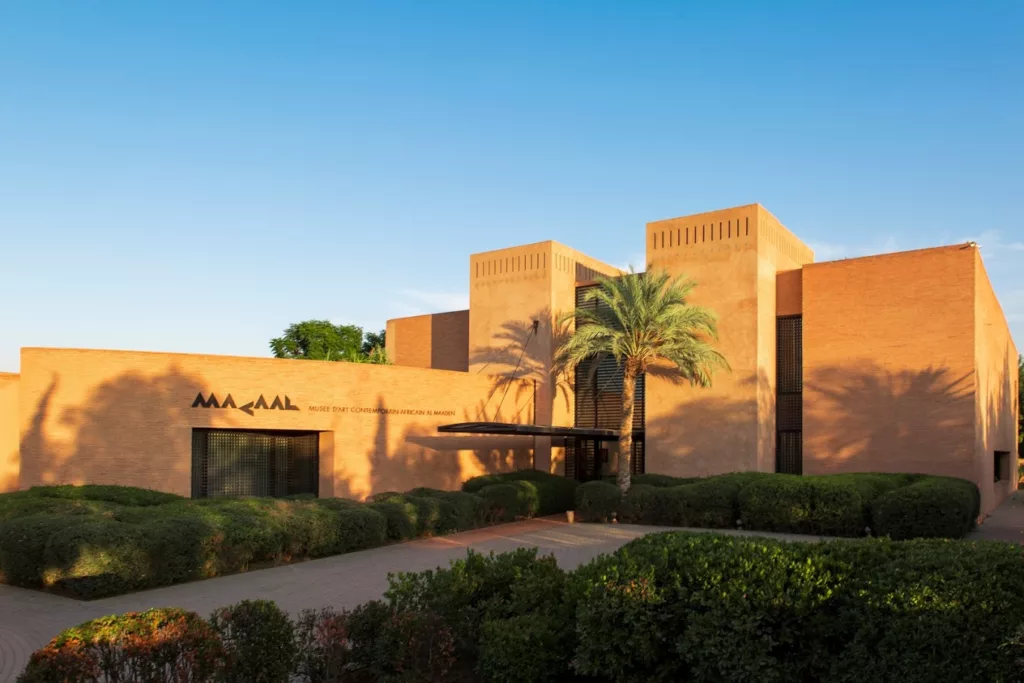
Immerse yourself in the diverse and vibrant world of African contemporary art by visiting the Museum of African Contemporary Art Al Maaden (MACAAL) in Marrakesh. An engaging and thought-provoking destination, MACAAL is dedicated to the promotion of African art and artists, serving as a rich cultural platform for the blossoming arts scene in Africa.
Opened to the public in 2016, the museum showcases a dynamic mix of art forms, from painting and sculpture to photography and video installations. The pieces on display represent a vast spectrum of styles, themes, and perspectives, offering a profound insight into the complexity and richness of the African art scene. The museum’s exhibitions are a blend of temporary exhibits featuring contemporary artists and a permanent collection that includes works from established African artists.
The space itself is a testament to beautiful design, with its sleek modern architecture providing a striking contrast to Marrakesh’s historical backdrop. It is nestled within the Al Maaden Golf Resort, adding to the overall allure.
MACAAL is more than a museum; it’s a celebration of African creativity and a commitment to fostering understanding and appreciation of African art around the world.
Voyagix Tips
To enhance your visit to MACAAL, consider the following tips:
- Plan Ahead: Check the MACAAL’s official website before your visit to stay updated on current exhibitions and events.
- Take a Guided Tour: To gain a deeper understanding of the art pieces, consider joining a guided tour. The guides are knowledgeable and provide insightful information about the artists and their work.
- Enjoy the Surroundings: The museum is located within the Al Maaden Golf Resort. If time allows, enjoy a walk around the resort or have a meal at one of its restaurants.
- Respect the Art: Remember to avoid touching the artworks and maintain silence in the galleries to respect other visitors’ experiences.
Whether you’re a seasoned art enthusiast or simply curious about African contemporary art, a visit to MACAAL offers an engaging and enriching cultural experience.
15. Enjoy a Camel Ride in the Palmeraie
When you’re ready for an adventure that’s truly unique to Marrakesh, plan a visit to the Palmeraie, a palm oasis located just outside the city. Here, you can embark on a memorable journey through the desert on the back of a camel, experiencing a traditional mode of transportation that has been part of Moroccan culture for centuries.
The Palmeraie, home to over 100,000 palm trees spread across 54 square miles, offers a stark contrast to the bustling city life of Marrakesh. It’s a tranquil haven, its greenery punctuated with luxurious resorts, private villas, and golf courses.
On your camel ride, you’ll meander through the palm groves, taking in the beautiful desert landscape as the sun casts long shadows on the sand. Trained guides accompany each camel trek, ensuring safety while sharing fascinating stories about Moroccan history and culture. Most tours also include traditional Moroccan tea and snacks, providing a taste of local hospitality.
There’s something uniquely calming and enchanting about gliding through the desert atop a camel, feeling the rhythm of its gentle strides. It’s an experience that transports you to a different time, a different pace of life, and leaves you with lasting memories.
Voyagix Tips
For a safe and enjoyable camel ride experience in the Palmeraie, consider these tips:
- Choose a Reputable Tour Operator: Ensure the operator treats their camels well. Dunes & Deserts is a popular and reliable choice.
- Dress Appropriately: Wear comfortable clothing and bring a hat, sunglasses, and sunscreen to protect yourself from the desert sun.
- Stay Hydrated: The desert heat can be intense, even in the cooler months. Bring water to stay hydrated.
- Respect Local Customs: When interacting with locals or taking photos, be respectful of Moroccan customs and traditions.
Whether you’re seeking adventure or tranquility, a camel ride through the Palmeraie provides a unique perspective on Marrakesh and a deeper connection with its rich culture.
16. Take a Hot Air Balloon Ride
For a truly unforgettable experience, consider embarking on a hot air balloon ride over the outskirts of Marrakesh. Ascending into the dawn skies, you’ll get a panoramic view of the city with the stunning Atlas Mountains as the backdrop. Nothing quite compares to the tranquility of drifting in a balloon, silently observing the world below.
Typically, your journey starts early in the morning when the air is calm and stable. As the sun begins to rise, casting golden hues across the landscape, the hot air balloon lifts off the ground, offering you the first glimpses of the magnificent vista. The city, with its sprawling medina and gardens, unfurls beneath you while the rugged peaks of the Atlas Mountains tower in the distance. The surreal beauty of the scene is breathtaking.
Most balloon rides last about an hour, but the memory of the experience, the peace, and serenity, will stay with you for a lifetime. After your descent, many companies serve a traditional Berber breakfast, giving you a chance to enjoy local cuisine while reminiscing about your aerial adventure.
Voyagix Tips
To make your hot air balloon ride over Marrakesh even more enjoyable, consider the following tips:
- Choose a Reliable Operator: Safety is paramount when it comes to hot air balloon rides. Ciel d’Afrique is one of the oldest and most trusted operators in the city.
- Dress in Layers: Mornings can be cool, but the sun will warm things up quickly. Dressing in layers will allow you to adjust to the changing temperatures.
- Bring a Camera: Don’t forget your camera or smartphone to capture the breathtaking views from the sky.
- Book in Advance: Hot air balloon rides are a popular activity and spaces fill up quickly, especially during the high season. To secure your spot, book well in advance.
Floating high above the city of Marrakesh and its surrounding landscape in a hot air balloon provides a perspective unlike any other, a bird’s eye view that will leave you with a sense of awe and a deeper appreciation for this beautiful region.
17. Try Moroccan Mint Tea
Throughout your exploration of Marrakesh, don’t miss the chance to sample a pot of traditional Moroccan mint tea. Also known as ‘Moroccan Whiskey,’ due to its popularity and the frequency it is served throughout the day, this refreshing beverage is more than just a drink — it’s a symbol of hospitality, friendship, and tradition.
The brewing process of Moroccan mint tea is an art in itself. Made from green tea leaves, fresh mint, and generous amounts of sugar, it is traditionally served in a beautifully adorned teapot and poured from a height into small, glass tea cups, creating a frothy top that enhances the sensory experience.
Moroccan mint tea is offered virtually everywhere, from casual street cafes to high-end restaurants. It’s also a customary gesture to welcome guests in Moroccan homes. The act of preparing and serving tea is seen as a sign of friendship and hospitality, and the drink is usually enjoyed in a leisurely manner, sipped slowly as part of social gatherings or after meals.
Voyagix Tips
To enhance your Moroccan mint tea experience, consider these tips:
- Visit Traditional Tea Houses: For an authentic experience, visit traditional tea houses like the Le Salon de Thé à La Maison Arabe, renowned for its beautiful decor and excellent mint tea.
- Respect the Ritual: Tea preparation is a cherished ritual in Morocco. Be patient and appreciate the brewing process, as it’s a part of the overall experience.
- Try Making It Yourself: Consider taking a Moroccan cooking class where you can learn the art of making the perfect pot of mint tea.
- Pair It with Moroccan Delicacies: Moroccan mint tea pairs well with traditional pastries like Gazelle’s Horns or almond Briouats. Don’t miss the opportunity to try these delicious combinations.
So, take a moment from your bustling travel itinerary to sit back, relax, and sip a pot of traditional Moroccan mint tea. It’s a simple pleasure that encapsulates the spirit of Moroccan culture and hospitality.
18. Visit the Tanneries
In the northeast of Marrakesh’s Medina, you’ll find the city’s traditional tanneries, an intriguing part of Moroccan heritage, offering a raw and authentic look into the age-old art of leather making. These tanneries have been a hub for the leather industry since the city’s inception, and the techniques used have changed little over the centuries.
Upon arrival, you’ll notice the distinctive smell, a blend of natural dyes and chemicals. Visitors are often given a sprig of mint to help mask the odour. Despite this, it’s a fascinating process to witness. You’ll see the craftsmen at work, soaking the hides of goats, sheep, cows, and camels in large vessels filled with a mixture of water, pigeon droppings, and ash to soften the hides and remove hair. The softened leather is then dyed using natural substances. For example, poppy flowers for red, indigo for blue, and saffron for yellow.
Once dyed, the leather is left to dry under the Moroccan sun and later crafted into a variety of products such as bags, shoes, and jackets. Many stalls and shops in the Medina sell these handcrafted items, and buying directly from these artisans is a wonderful way to support the local economy.
Voyagix Tips
To make the most out of your visit to Marrakesh’s tanneries, consider these tips:
- Guided Tours: It’s best to take a tour with a local guide. They can explain the tanning process, help with language barriers, and ensure you don’t get lost in the labyrinth of the Medina. Websites like GetYourGuide offer a variety of guided tours.
- Stay Alert: The tanneries are located in a less touristy part of the Medina, so keep your belongings close and be wary of unofficial guides.
- Photography: The tanneries are a unique visual experience, but always ask for permission before taking photographs. Some tanneries may charge a small fee for photos.
- Shopping: If you plan to buy leather goods, remember to haggle. Bargaining is a part of the shopping culture in Morocco.
Visiting the tanneries in Marrakesh is a trip back in time, providing a glimpse into the city’s artisan heart, where traditional crafts continue to flourish.
19. Attend a Gnawa Music Performance
Dive into the rich tapestry of Moroccan culture by experiencing a Gnawa music performance. Originating from the spiritual traditions of the sub-Saharan African Gnawa people, this form of music has deep historical roots, reflecting the culture, resilience, and spirituality of its people. Today, Gnawa music is considered an integral part of Moroccan heritage, and its hypnotic rhythms and stirring melodies captivate both locals and visitors alike.
The music is characterized by its distinctive instrumentation. Musicians, known as Maalems, play the guembri (a three-stringed bass instrument), while others play the krakebs (large iron castanets), providing a mesmerizing percussive accompaniment. The resulting sound is trance-like and vibrant, often accompanied by ritual dancing and singing, creating an immersive experience that speaks to the soul.
Whether performed in intimate venues, music festivals, or spontaneous street gatherings, Gnawa music has an undeniable energy that draws you in. The rhythm and pace can vary from slow and steady to a fevered crescendo, culminating in an electrifying performance that leaves spectators in awe.
Voyagix Tips
To enjoy the best of Gnawa music in Marrakesh, consider these tips:
- Live Performances: Several venues in Marrakesh offer live Gnawa music performances. Dar Essalam, a historic restaurant, is one such place. You can enjoy a traditional Moroccan meal while experiencing the exhilarating Gnawa music performance. For details, visit the Dar Essalam’s official website.
- Gnawa Music Festivals: If your travel dates align, consider attending the Gnaoua World Music Festival in Essaouira, a seaside town near Marrakesh. This internationally acclaimed festival showcases the best Gnawa musicians and attracts artists from around the globe. For more information, check the official festival website.
- Respect the Culture: Remember that Gnawa music has spiritual significance, so be respectful during performances. Avoid talking loudly and keep your mobile device on silent.
- Participation: During some performances, audience participation is encouraged. Don’t be shy to clap along or join in the dancing if invited!
Experiencing a Gnawa music performance is a unique cultural experience that resonates deeply, revealing the soulful and vibrant spirit of Moroccan heritage.
20. Visit the House of Photography
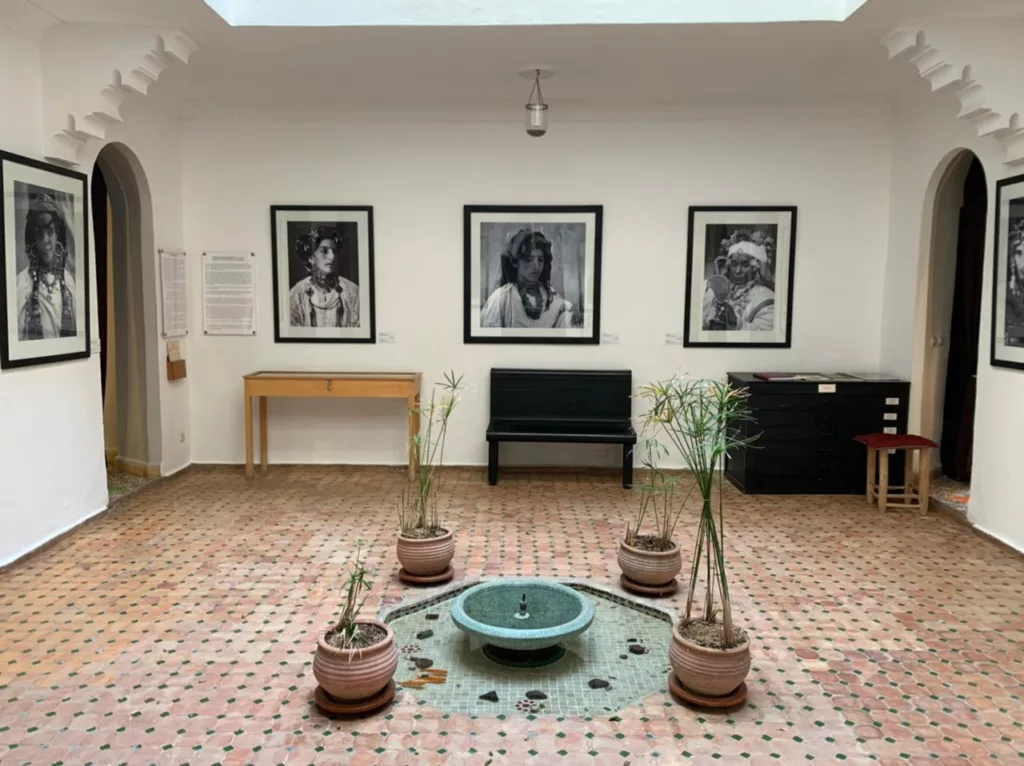
Get a glimpse into Morocco’s past by stepping into the House of Photography in Marrakesh. This delightful museum showcases an impressive collection of photographs dating from the late 19th century to the mid-20th century. The images, curated from private collections and global archives, paint a vivid picture of Moroccan life across different eras, capturing moments in time and immortalizing them.
Housed in a restored 19th-century Riad in the heart of the Medina, the House of Photography is a treasure trove of historical and cultural significance. As you wander through the rooms, you’ll discover black and white photographs, glass negatives, postcards, and documentary films, each telling a unique story of Morocco’s history, its people, landscapes, and changing society.
From candid street scenes to stunning panoramic shots of landscapes and portraits of Moroccan people, the collection reveals the country’s rich and varied heritage. The museum also offers a stunning rooftop terrace that provides a breathtaking view of the Medina and the Atlas Mountains, adding an extra layer of charm to your visit.
Voyagix Tips
For an optimal visit to the House of Photography, consider these tips:
- Getting There: The House of Photography is located in the Medina, easily accessible by foot from the main square, Jemaa el-Fnaa. Follow the signposts in the Medina to find your way.
- Guided Tours: The museum offers guided tours. It’s worth taking one to gain more insights into the stories behind the photographs. Check out the official website for more information.
- Time Your Visit: Allow at least an hour to take in the vast collection. Don’t forget to visit the rooftop terrace for a panoramic view of Marrakesh.
- Photography: You are allowed to take photographs of the exhibits, but avoid using flash to preserve the integrity of the photographs.
The House of Photography provides a unique opportunity to delve into Morocco’s past, capturing not only the beauty of its landscapes and architecture but also the everyday life and evolution of its people.
21. Explore the Menara Gardens
The perfect finale to your Marrakesh adventure awaits at the tranquil Menara Gardens, a lush and serene oasis away from the city’s hustle and bustle. These historic gardens, established in the 12th century during the Almohad dynasty, are a testament to the city’s rich history and its people’s enduring relationship with nature.
The Menara Gardens encompass a large orchard of olive trees, complemented by palm, cypress, and fruit trees, all meticulously arranged in typical Islamic gardening tradition. The heart of the gardens is a stunning artificial lake fed by a sophisticated hydraulic system of underground channels. This man-made marvel, reflecting the pavilion and surrounding trees, contributes to the overall peace and tranquility of the place.
Overlooking the lake, stands a beautiful Saadian pavilion, initially built in the 16th century and renovated in the 19th century. The pavilion and its green-tiled pyramidal roof offer a stunning backdrop for memorable photos, especially with the snow-capped Atlas Mountains visible in the distance.
Whether you’re up for a leisurely stroll amidst the olive groves, a peaceful boat ride on the lake, or just sitting back to enjoy the panoramic views, the Menara Gardens provide a perfect sanctuary of tranquility and beauty.
Voyagix Tips
To ensure a delightful visit to the Menara Gardens, consider the following tips:
- Getting There: The gardens are located about 3 kilometers from the city center, accessible by taxi or horse-drawn carriage. You can also choose to walk if you prefer a more leisurely pace.
- Best Time to Visit: Early morning or late afternoon are perfect for avoiding the heat. The gardens are also particularly enchanting during the spring when the trees are in bloom.
- Enjoy the Scenery: Don’t forget to bring your camera to capture the beautiful views, especially the sight of the pavilion reflected in the lake.
- Picnic Spot: The gardens provide an ideal spot for a picnic. Feel free to bring along some local delicacies to enjoy amidst the scenic surroundings.
The Menara Gardens are not only a place of historic and cultural significance but also a peaceful retreat that offers a soothing conclusion to your exploration of the enchanting city of Marrakesh.
Conclusion
Marrakesh, with its labyrinthine alleys, vibrant markets, grand palaces, and serene gardens, offers a kaleidoscope of experiences for the intrepid traveler. Whether you’re visiting for the first time or returning to uncover more of its magic, the city promises an unforgettable journey that engages all your senses. From its bustling markets to its peaceful gardens, Marrakesh never fails to captivate those who walk its winding paths.
As you navigate the city’s bustling Medina or find solace in the serenity of its Majorelle Garden, every experience in Marrakesh is a moment to be treasured. Its intoxicating blend of history, culture, and charm creates an atmosphere that is at once thrilling and tranquil, invigorating and relaxing. So pack your bags and get ready to explore these 21 must-do things in Marrakesh. Each journey promises to be an adventure of discovery, unveiling the city’s mesmerizing blend of tradition and modernity, history, and culture. For, in the end, it’s not just about visiting a city; it’s about living an experience, and Marrakesh offers an experience that stays with you long after you’ve left its red-hued walls.

